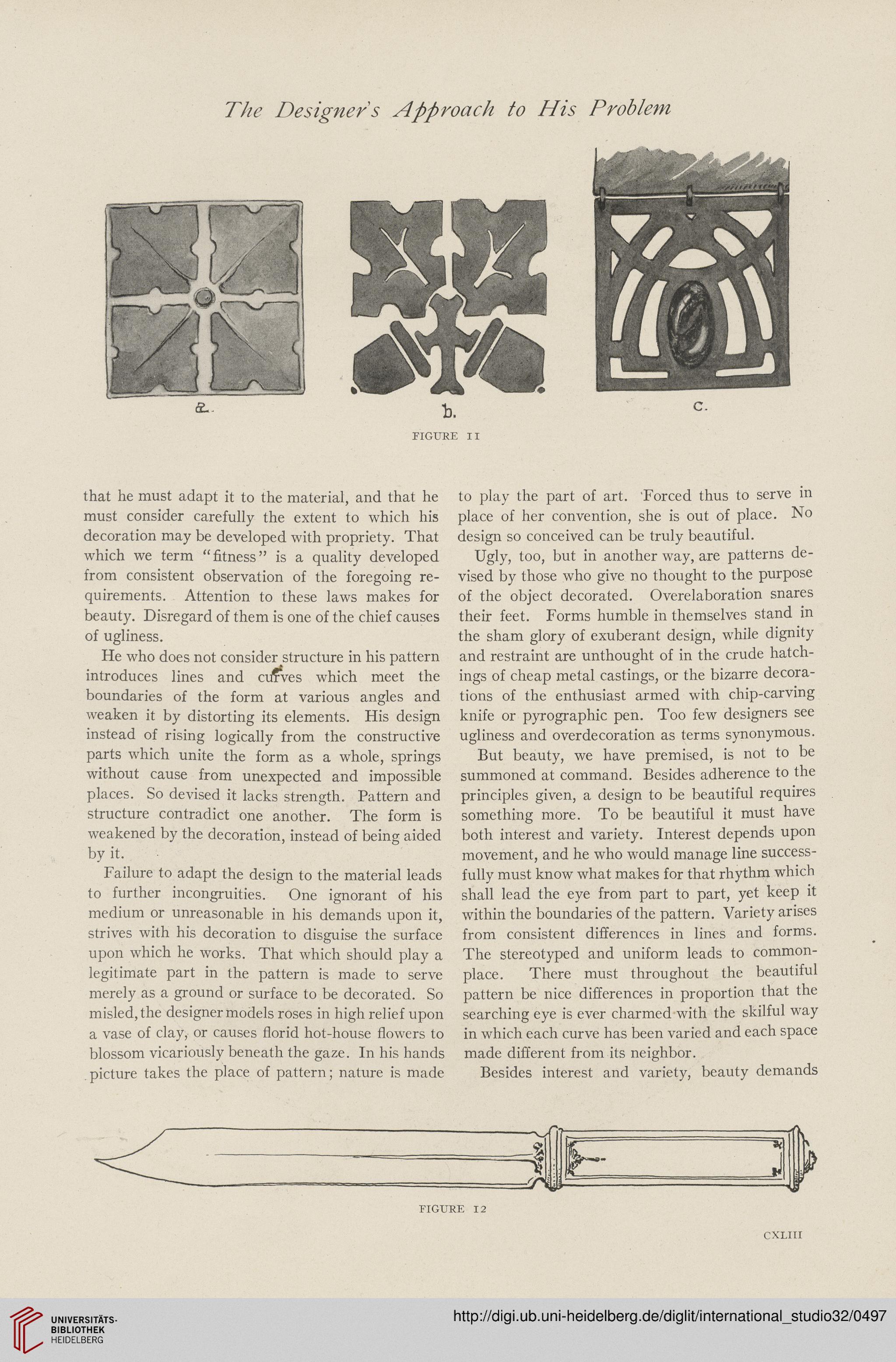The Designer s Approach to His Problem
FIGURE II
that he must adapt it to the material, and that he
must consider carefully the extent to which his
decoration may be developed with propriety. That
which we term “fitness” is a quality developed
from consistent observation of the foregoing re-
quirements. Attention to these laws makes for
beauty. Disregard of them is one of the chief causes
of ugliness.
He who does not consider structure in his pattern
introduces lines and ciifves which meet the
boundaries of the form at various angles and
weaken it by distorting its elements. His design
instead of rising logically from the constructive
parts which unite the form as a whole, springs
without cause from unexpected and impossible
places. So devised it lacks strength. Pattern and
structure contradict one another. The form is
weakened by the decoration, instead of being aided
by it.
Failure to adapt the design to the material leads
to further incongruities. One ignorant of his
medium or unreasonable in his demands upon it,
strives with his decoration to disguise the surface
upon which he works. That which should play a
legitimate part in the pattern is made to serve
merely as a ground or surface to be decorated. So
misled, the designer models roses in high relief upon
a vase of clay, or causes florid hot-house flowers to
blossom vicariously beneath the gaze. In his hands
picture takes the place of pattern; nature is made
to play the part of art. 'Forced thus to serve in
place of her convention, she is out of place. No
design so conceived can be truly beautiful.
Ugly, too, but in another way, are patterns de-
vised by those who give no thought to the purpose
of the object decorated. Overelaboration snares
their feet. Forms humble in themselves stand in
the sham glory of exuberant design, while dignity
and restraint are unthought of in the crude hatch-
ings of cheap metal castings, or the bizarre decora-
tions of the enthusiast armed with chip-carving
knife or pyrographic pen. Too few designers see
ugliness and overdecoration as terms synonymous.
But beauty, we have premised, is not to be
summoned at command. Besides adherence to the
principles given, a design to be beautiful requires
something more. To be beautiful it must have
both interest and variety. Interest depends upon
movement, and he who would manage line success-
fully must know what makes for that rhythm which
shall lead the eye from part to part, yet keep it
within the boundaries of the pattern. Variety arises
from consistent differences in lines and forms.
The stereotyped and uniform leads to common-
place. There must throughout the beautiful
pattern be nice differences in proportion that the
searching eye is ever charmed with the skilful way
in which each curve has been varied and each space
made different from its neighbor.
Besides interest and variety, beauty demands
-%
J
FIGURE 12
CXLIII
FIGURE II
that he must adapt it to the material, and that he
must consider carefully the extent to which his
decoration may be developed with propriety. That
which we term “fitness” is a quality developed
from consistent observation of the foregoing re-
quirements. Attention to these laws makes for
beauty. Disregard of them is one of the chief causes
of ugliness.
He who does not consider structure in his pattern
introduces lines and ciifves which meet the
boundaries of the form at various angles and
weaken it by distorting its elements. His design
instead of rising logically from the constructive
parts which unite the form as a whole, springs
without cause from unexpected and impossible
places. So devised it lacks strength. Pattern and
structure contradict one another. The form is
weakened by the decoration, instead of being aided
by it.
Failure to adapt the design to the material leads
to further incongruities. One ignorant of his
medium or unreasonable in his demands upon it,
strives with his decoration to disguise the surface
upon which he works. That which should play a
legitimate part in the pattern is made to serve
merely as a ground or surface to be decorated. So
misled, the designer models roses in high relief upon
a vase of clay, or causes florid hot-house flowers to
blossom vicariously beneath the gaze. In his hands
picture takes the place of pattern; nature is made
to play the part of art. 'Forced thus to serve in
place of her convention, she is out of place. No
design so conceived can be truly beautiful.
Ugly, too, but in another way, are patterns de-
vised by those who give no thought to the purpose
of the object decorated. Overelaboration snares
their feet. Forms humble in themselves stand in
the sham glory of exuberant design, while dignity
and restraint are unthought of in the crude hatch-
ings of cheap metal castings, or the bizarre decora-
tions of the enthusiast armed with chip-carving
knife or pyrographic pen. Too few designers see
ugliness and overdecoration as terms synonymous.
But beauty, we have premised, is not to be
summoned at command. Besides adherence to the
principles given, a design to be beautiful requires
something more. To be beautiful it must have
both interest and variety. Interest depends upon
movement, and he who would manage line success-
fully must know what makes for that rhythm which
shall lead the eye from part to part, yet keep it
within the boundaries of the pattern. Variety arises
from consistent differences in lines and forms.
The stereotyped and uniform leads to common-
place. There must throughout the beautiful
pattern be nice differences in proportion that the
searching eye is ever charmed with the skilful way
in which each curve has been varied and each space
made different from its neighbor.
Besides interest and variety, beauty demands
-%
J
FIGURE 12
CXLIII




